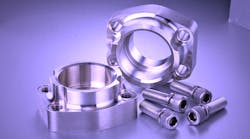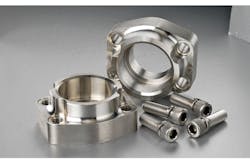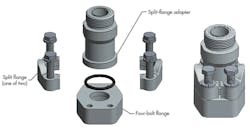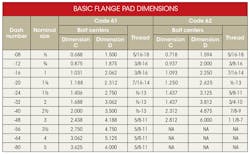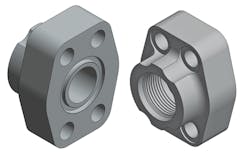Hereâs a four-bolt flange from two viewpoints: port connection side (left) and flange connection side (right).
Materials and Finish
Flanges are generally produced in carbon steel and stainless steel, and occasionally in aluminum, alloys, or other exotic metals to meet particular application demands. Since tensile and yield strengths vary between material types, it is important to verify that maximum working pressures are not affected by the material selection.
Though many OEMs paint the entire hydraulic system after fabrication is complete, plating or other finishes can be applied to improve the corrosion resistance and prolong the flange’s life in the field. Carbon-steel components may receive plating such as silver trivalent or zinc-nickel, while stainless steel might be passivated or electro-polished.
Assembly Hardware
Choosing the appropriate hardware, or fastener, is just as important as choosing the right flange. Not only should the type of thread be identified (UNC or metric), but also the proper thread length. Thread engagement is typically provided within the flange specification. However, he flange manufacturer often accounts for it when hardware is supplied as a complete set with the flange. It is common for hex head fasteners to be provided with split-flange connections and socket-head fasteners with four-bolt flanges. In certain applications, special high-strength fasteners can be used because of their ability to resist elongation or stretching, which could result in failure of the flange connection.
Standards continue to be updated, and play a key role in flange selection. In addition, manufacturing and improvements in materials are yielding pressure ratings higher than the industry has ever seen. Big changes are happening in the fluid-power industry, and hydraulic flanges are no exception.
Tim Abrams is Inside Sales Manager and Tom Jones is Technical Sales at Anchor Fluid Power, Cincinnati. For more information, call (866) 352-6437, or visit www.anchorfluidpower.com.
